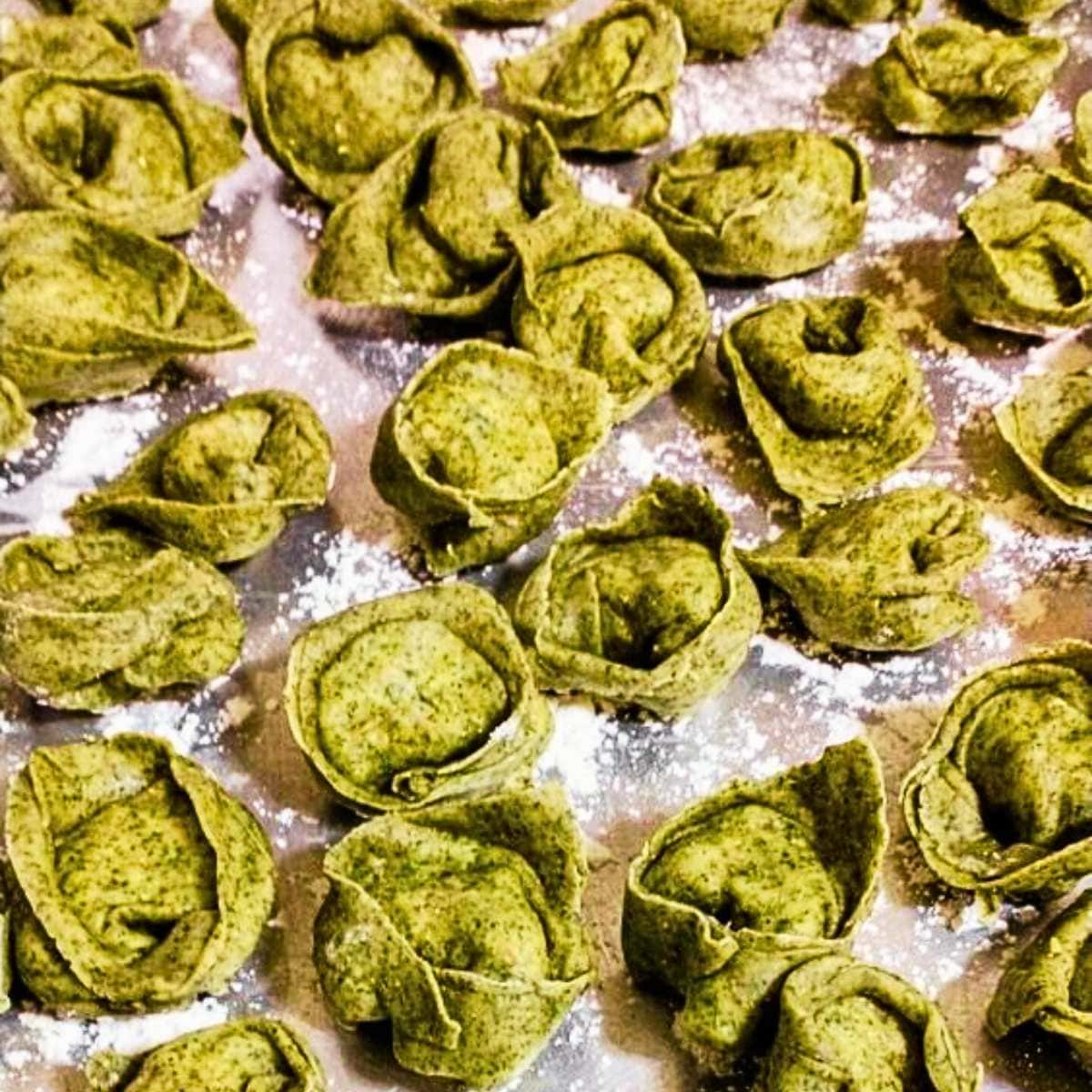COOK/FORAGE: Parmesan Artichoke Tortellini with Lambsquarter and Black Pepper Pasta
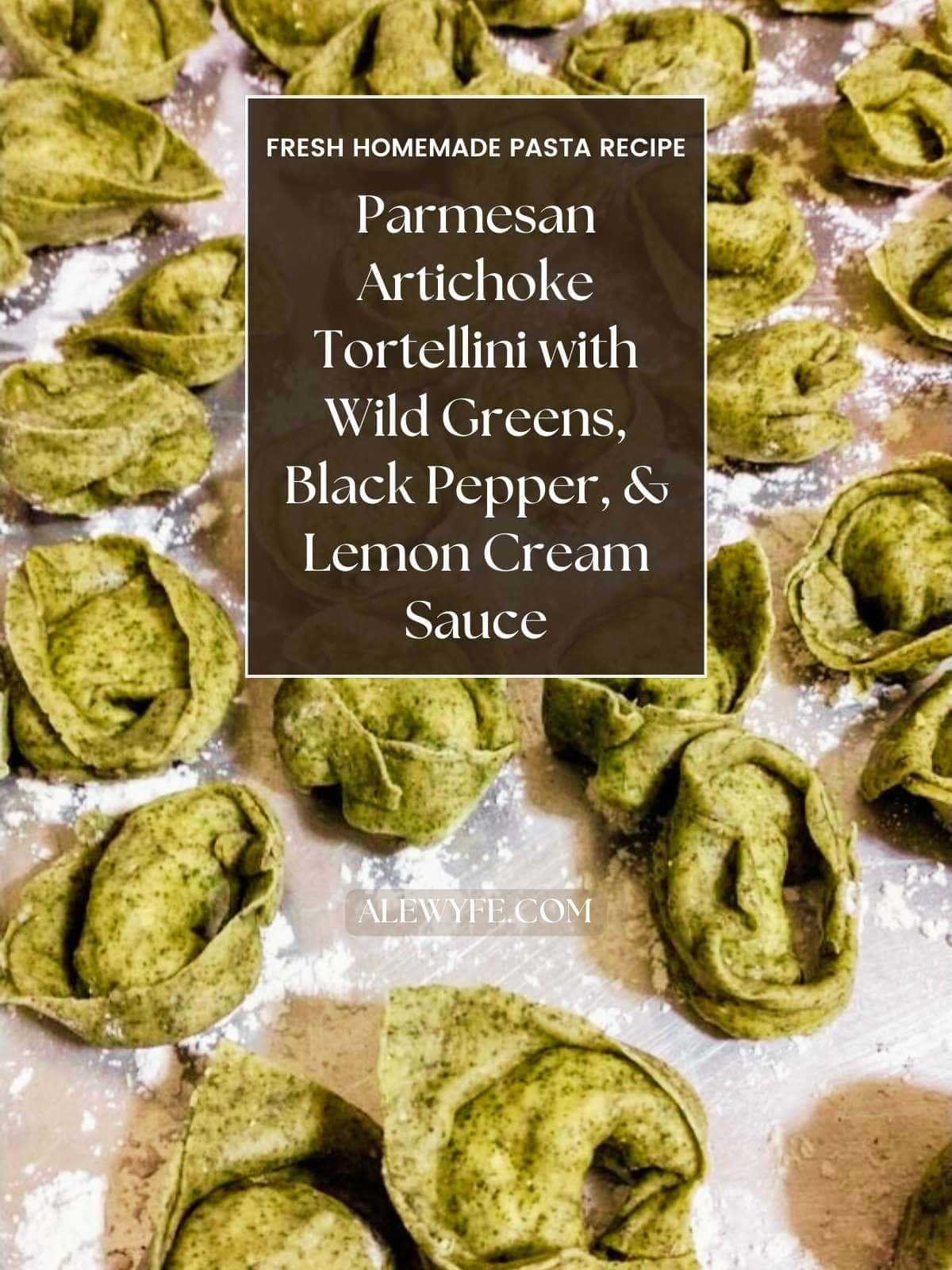
Learn to make this fresh, homemade bright green pasta at home, with farm fresh eggs, a rich but simple savory filling, and a quick but luscious sauce, although it’s also fantastic served “en brodo” in a bowl of rich broth as an appetizer… these parmesan artichoke tortellini with wild foraged greens are absolutely delicious.
Use wild foraged greens or substitute spinach or baby greens if you don’t have lambsquarters… whatever you use, this special pasta is worth the effort and freezes beautifully if you’d like to make and save it for an occasion or a busy evening. Mangiare!
What’s a chicken-tender to do with all these eggs?
Make Fresh Pasta!
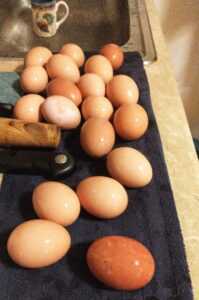
Well, it’s definitely spring now, and the chickens are laying like gangbusters… it’s the end of the winter egg drought and now we’re drowning. I know this is coming but it’s still a little surprising every year. Time to make more fresh homemade pasta to make a dent in the egg bounty, and these parmesan artichoke tortellini are a great way to do that.
These tortellini are a little more work than regular plain egg noodles, but totally worth the *eggstra* effort, and as a bonus, they are a tasty way to work in some of the nutritious dried lambsquarters that I squirrel away in the pantry every season.
Drying and Using Foraged Lambsquarters
You can use a regular spinach pasta recipe for these (substituting blanched and pureed fresh lambsquarters, or spinach if you don’t have access to the wild greens) but I have been experimenting with ways to use the bunches of lambsquarters (Chenopodium album) that I pick and dry from our garden every summer. A member of the amaranth family, it is also known as pigweed, goosefoot, fat-hen, bacon weed, and all-good. They’re cultivated intentionally in some places but mostly fell out of favor when spinach was introduced to the western diet from Asia, and are mostly an escaped invasive here in North America. But unlike spinach, they’re so easy to grow that they usually grow themselves, don’t bolt and disappear in hot weather or need cool soil conditions to germinate, so it’s worth learning how to love this plant.
They also grow abundantly in fields, farms, and parks, anywhere temperate and sunny where the soil has been disturbed, and they’re not native and spread abundantly so you don’t have to worry about overharvesting. Make sure if you’re gathering wild ones that they haven’t been sprayed, exposed to roadside exhaust and runoff, or toxic soil conditions, as like many leafy greens, they are especially good at picking up contaminants.
No dehydrator needed- just tie off a clean bundle of the leafy stalks with twine (or bunch with twist ties) and hang somewhere dry and out of the sun (I use our attic or pantry). Once they’re dry, strip the leaves and any seeds from the stems and pack into jars or airtight storage containers to protect them from dust and bugs (I leave extra bunches hanging in the attic to take down and give to the chickens for a winter treat and something to pick at when they’re snowed in).
They’re a great source of vitamins and nutrients in the dark winter months, and since they grow like, well, weeds, I can easily dry a whole lot. I crumble the leaves into soups and stews, and make a finer sieved powder to add to pasta, savory baked goods, egg dishes, and more.
Filling and Shaping the Tortellini
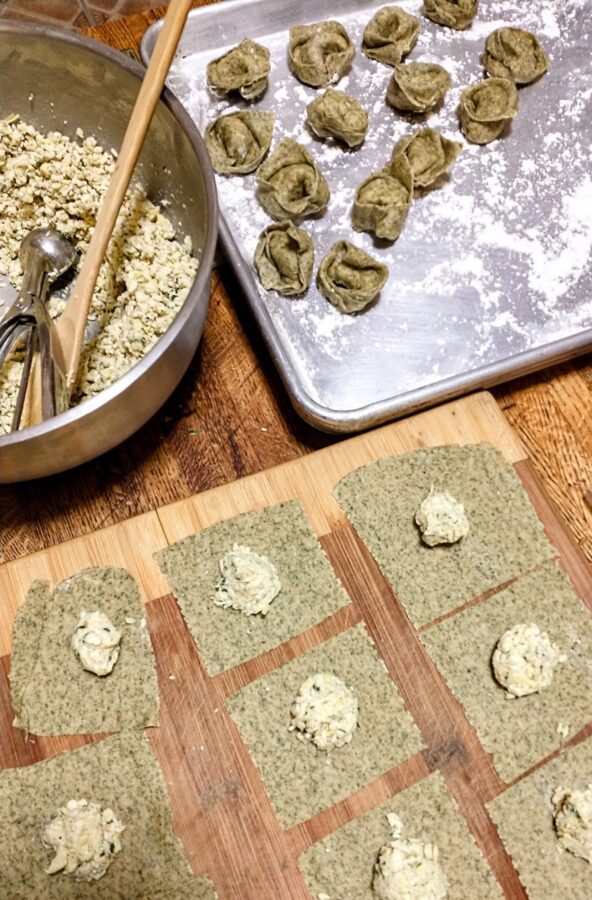
You can serve these tortellini tossed simply with butter and more grated parmesan, more traditionally floating “en brodo” (simmered in a pot of richly flavored homemade stock and ladled into bowls), or you can gild the lily and swath them in a rich but bright lemony cream sauce that comes together quickly in just one pan.
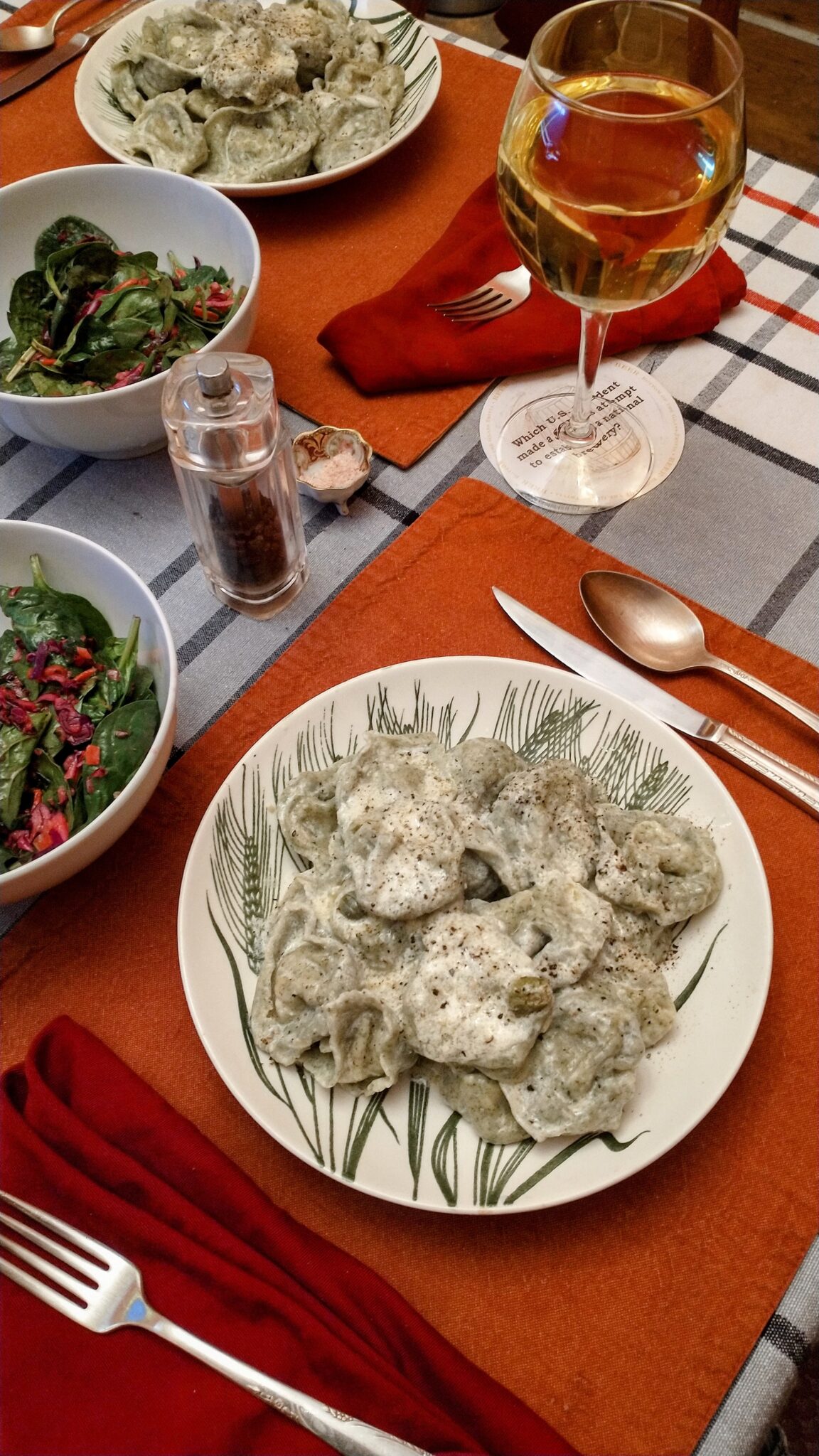
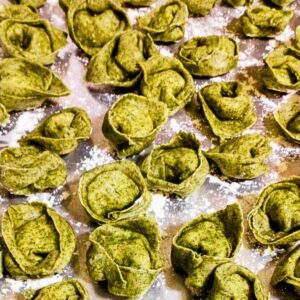
Parmesan Artichoke Tortellini with Lambsquarter and Black Pepper Pasta and Lemon Cream Sauce
Ingredients
Lambsquarter and Black Pepper Pasta
- 2 cups all purpose flour
- ½ cup semolina flour (can substitute all purpose)
- ½ cup dried lambsquarters ground and coarsely sifted
- 1 pinch salt
- ½ tsp black pepper
- 4 eggs
Parmesan Artichoke Filling
- 1 cup artichoke hearts quartered
- 6 cloves garlic crushed and chopped
- 2 tbsp butter
- ½ tsp thyme double for fresh herbs
- ½ tsp marjoram double for fresh herbs
- ½ tsp freshly ground black pepper or to taste
- 6 oz cream cheese, softened substitute mascarpone cheese if available, and increase breadcrumbs to 1 cup
- ¾ cup bread crumbs
- 1 cup grated Parmesan cheese
Lemon Cream Sauce
- 2 tbsp butter
- 4 cloves garlic minced
- 4 oz dry white wine
- 16 oz heavy cream
- zest from one lemon microplaned or finely grated
- 1 sprig lemon thyme can substitute regular thyme
- ⅛ tsp freshly grated nutmeg
- 2 tbsp lemon juice
Instructions
Lambsquarter and Black Pepper Pasta
- Prepare the dried lambsquarters. Strip leaves from the coarse stems and pack into a food processor or blender. Don't worry about the seeds if present- they'll add a nice crunch and a lot of nutritional value to the pasta.
- Pulse to grind the greens as finely as possible. If you are using a blender, stop and shake the jar to redistribute. Using a coarse mesh strainer or tamis, sift the ground greens into a bowl. Regrind the larger pieces that do not pass through the strainer and sift again. You can repeat this until most of the leaves are sifted, or save the larger pieces to add to soups- you only want very fine pieces for the pasta. Measure out ½ cup of the finely ground lambsquarters.
- In a medium mixing bowl or food processor, combine the ground lambsquarters, flour, black pepper, and salt and stir or pulse a few times to mix. If you are working by hand, make a well in the center of the dry ingredients.
- Add the eggs to the food processor and pulse a few times just until combined. The dough will look dry and crumbly but if you squeeze it, it should come together and feel supple but not too tacky. If you are working by hand, use a fork to blend the eggs together and then gradually incorporate the flour until you have a stiff dough.
- Turn the dough out onto a lightly floured surface and knead until smooth and elastic. If it is too dry, you can work in some water, no more than a tsp at a time, and if it's too wet, knead in more flour. The dried lambsquarters will hydrate and absorb moisture from the dough as it rests, so you can make it a little stickier than regular pasta dough, but it shouldn't stick to floured hands.
- When you are satisfied with the consistency, wrap the dough tightly and let rest. You can make it a day or two ahead- wrap well and chill in the fridge. The outside of the dough may discolor slightly but it will be fine to use.
Parmesan Artichoke Filling
- In a medium saute pan, sweat garlic in butter with a pinch of salt until it is fragrant and just beginning to color. Add herbs to the pan and season to taste with fresh black pepper.
- Add the quartered or rough chopped artichoke hearts and saute lightly for a few minutes to evaporate the liquid.
- Let cool slightly, then transfer to a food processor bowl. Add the cream cheese and breadcrumbs and pulse lightly to combine.
- Add the parmesan cheese and pulse again. The filling should be somewhat dry but hold together when lightly squeezed. Adjust consistency with more breadcrumbs and parmesan if it's too wet, or a splash of heavy cream or stock if it's too dry.
Shaping the Tortellini
- Cut the dough into quarters and work with one piece at a time, keeping the rest wrapped so that they don't dry out. Roll the dough out by hand on a large lightly floured surface, or use a pasta machine to roll the dough (preferred). You should be able to see the shadow of your hand behind the dough when you hold it up. On my pasta machine, I roll this dough to the second thinnest setting- if you go too thin it may tear because of the lambsquarters and pepper.
- I roll and fill each sheet of dough as I go rather than rolling out all the sheets at once- if they dry out too much it will be harder to get a good seal when you shape the pasta. Lay the sheets out onto a worksurface, and cut the dough into roughly 3" squares (they don't have to be perfect). Put about a teaspoon of filling in the center of each square - a small cookie scoop works well for this and keeps your hands clean for shaping the dough.
- Fold each dough square in half diagonally over the filling. Pinch the edges together, pressing out the air as you go. You may need to use a bit of water with a fingertip or small pastry brush if your dough is dry. Place your left index finger next to the center of the long edge of dough by the filling, and with your right hand, grab the two corners of the long ends and tuck them together (reverse this if you are left handed). Pinch the ends to seal and secure the tortellini shape.
- Place the finished tortellini on a lightly floured sheet pan and continue rolling, filling, and shaping the remaining tortellini.
- You can make these in advance up to an hour, refrigerate up to a day, or freeze for storage up to 3 months (freeze in a single layer on sheet pans for an hour before bagging in ziplocks or sealed containers so they don't stick together). If you are preparing them immediately, put a large pot of salted water on to boil and start the sauce.
Lemon Cream Sauce
- Sweat garlic in butter with a pinch of salt until fragrant- do not let it brown. Deglaze the pan with the white wine, add the thyme, and cook down until most of the liquid evaporates and only a few tablespoons remain.
- Add the cream, nutmeg, and lemon zest to the pan and simmer on low heat to reduce by almost half.
- When the cream has reduced to nappe consistency (it will lightly coat a spoon), drop the pasta in the boiling salted water. If you are cooking from fresh, it will cook in just a few minutes- scoop or drain the pasta when they float to the surface (taste test one for consistency). If the pasta has been in the fridge or freezer, add a few minutes to the cook time but do not overcook.
- Remove the sauce from the heat and add the lemon juice. Taste and adjust seasoning if necessary, then toss the cooked pasta with the sauce.
- Plate and serve immediately, with freshly grated parmesan and black pepper to garnish. Serves 4 as a main course, and 6-8 as an appetizer.
